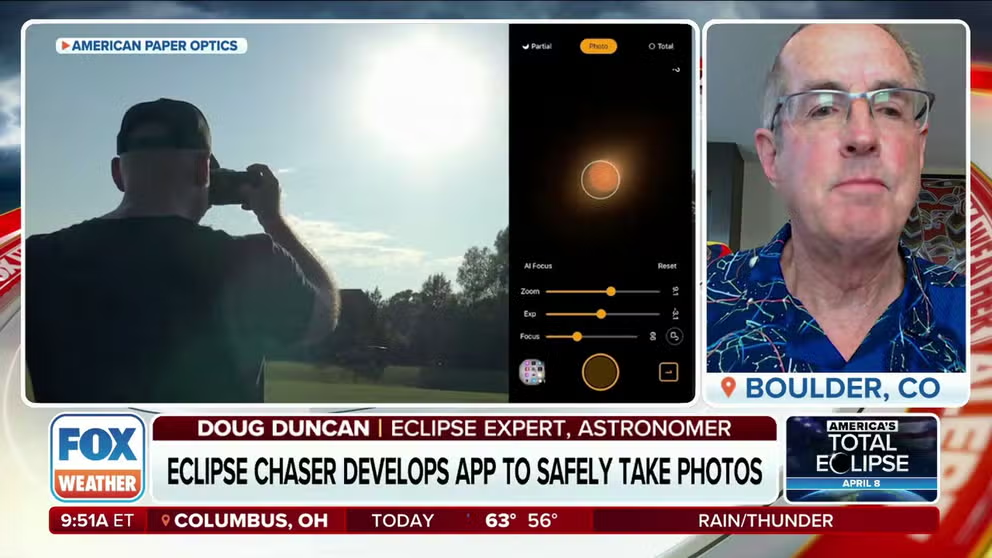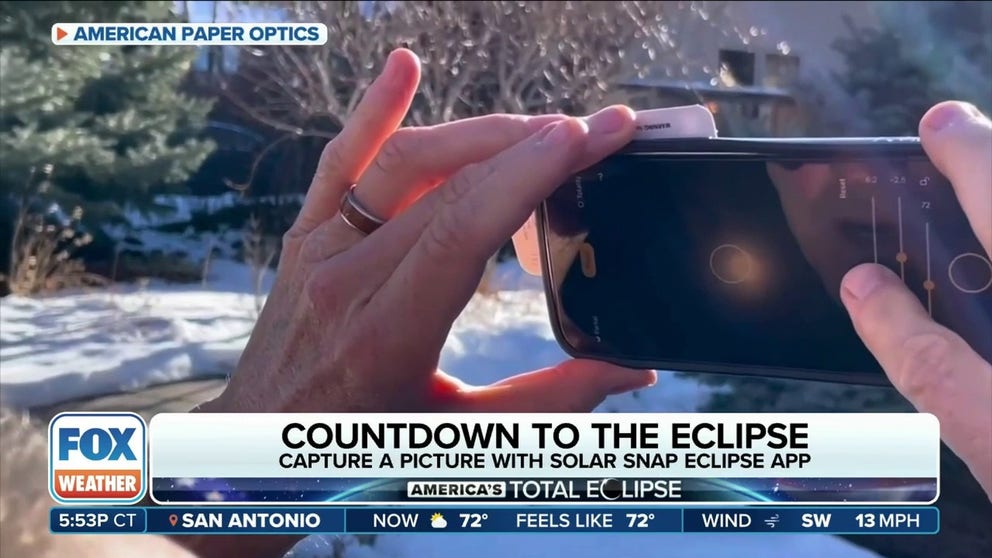How to photograph the April total solar eclipse with your phone
It's not safe to look directly at the Sun without eclipse glasses because you could burn your retinas. Similarly, your smartphone lens focuses light and should not be used to photograph the Sun without a solar filter.
How to safely photograph the solar eclipse with your phone
Astronomer and eclipse chaser Doug Duncan explains how you can use a solar filter and an app to capture the April 8th total solar eclipse.
This will be one of the many reminders you will receive before the April 8th total solar eclipse that your eyes need protection to watch the celestial event, but what about the lens of your phone's camera?
Like your eyes, your smartphone lens cannot look directly at the Sun. This puts a damper on the eclipse photos you hope to capture of the big event when the total solar eclipse crosses a slice of America from Texas to Maine. This is where a solar filter for your phone can help.
Experienced eclipse chaser and former Hubble Space Telescope astronomer Doug Duncan said it's not too late to order a Solar Snap filter, which will work with any smartphone camera.
HOW TO SAFELY WATCH A SOLAR ECLIPSE
Duncan said the idea for the filter and the Solar Snap app came after his 12th solar eclipse. American Paper Optics, a trusted U.S. eclipse glasses manufacturer, makes the filters. The Solar Snap kit has two filters, two sets of Velcro to attach the filters and two pairs of eclipse glasses.

An eclipse watcher uses the Solar Snap filter to watch the October 2023 annular eclipse. (Photo credit: American Paper Optics)
"The reason I invented it was I saw people trying to take pictures of the Sun," Duncan told FOX Weather. "But your phone wasn't designed for pictures of the Sun; it was designed for pictures of people."
After getting your solar filter in the mail, Duncan recommends users try out the app around the house with their phone before taking it outside to use the filter to photograph the Sun. While using the app on the Sun, users should look at the screen on the phone, not the Sun. The app can lock the focus on the Sun and capture clear images of our solar system's star.
Why do you need a solar filter for your phone?
Think of the science experiments you did as a child using a magnifying glass to focus sunlight on a piece of paper, causing a hole to burn.
"Your eye has a lens, and it focuses light, and if you didn't protect your eyes, you could burn your retina," Duncan said.
It is only safe to look directly at the Sun while wearing special-purpose solar filter glasses. According to the American Astronomical Society, these glasses must meet the ISO 12312-2 international standard for direct Sun viewing.
How to take stunning photos of the eclipse with your phone
More than 30 million Americans are estimated to live in the path of totality, with many millions more expected to travel to the 15 states where the event will be visible.
Your smartphone also has a lens that focuses light and needs protection.
WHY WEARING RED OR GREEN COULD ENHANCE YOUR SOLAR ECLIPSE EXPERIENCE
"And it needs a filter just like your eyes. And so that's what the Solar Snap is," Duncan said. "It's a single little filter and a piece of Velcro, and it goes right over your camera," Duncan explains.
In addition to protecting your eyes and camera lens, the forecast is essential for the April 8th total solar eclipse. The FOX Forecast Center continues to provide cloud-cover forecasts for the more than 100-mile-wide path of totality from the Southwest to the Northeast.

Jeremy Veldman, with the Memphis Astronomical Society, tests the Solar Snap filer and app.
(American )
TOTAL SOLAR ECLIPSE FORECAST SHOWS WHO HAS BEST CHANCE FOR CLEAR SKIES ON APRIL 8TH
Months ahead of time, April weather patterns and historical cloud climatology helped eclipse chasers determine where to watch the eclipse, but clouds do happen. Duncan said even with cloud cover in the forecast, this might not ruin your chance to see totality.
"At a couple of eclipses, I've been where it was cloudy, but the clouds have dissipated right before the eclipse and let us watch," Duncan said.
FOX Weather Correspondent Robert Ray had the same experience in San Antonio, Texas, during the October 2023 annular eclipse. The clouds moved on just in time for spectators at the Alamo to see the "ring of fire."

